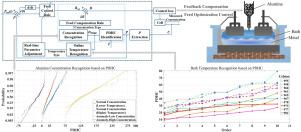当前位置:
X-MOL 学术
›
Control Eng. Pract.
›
论文详情
Our official English website, www.x-mol.net, welcomes your
feedback! (Note: you will need to create a separate account there.)
A mechanism knowledge-driven method for identifying the pseudo dissolution hysteresis coefficient in the industrial aluminium electrolysis process
Control Engineering Practice ( IF 5.4 ) Pub Date : 2020-09-01 , DOI: 10.1016/j.conengprac.2020.104533 Zhaohui Zeng , Weihua Gui , Xiaofang Chen , Yongfang Xie , Renchao Wu
Control Engineering Practice ( IF 5.4 ) Pub Date : 2020-09-01 , DOI: 10.1016/j.conengprac.2020.104533 Zhaohui Zeng , Weihua Gui , Xiaofang Chen , Yongfang Xie , Renchao Wu

|
Abstract To overcome the difficulties that are associated with the online recognition of the alumina dissolution properties in industrial aluminium electrolysis cells, this paper proposes a method driven by process mechanism knowledge for the identification of a pseudo dissolution hysteresis coefficient (PDHC). The method explicitly represents the process semantemes that are implied in the normalized cell voltage (NCV) and the feed state using the proposed PDHC via process mechanism analysis and process semantic embedding. The PDHC quantifies the online dissolution performance of alumina and, thus, can overcome the inability to express the alumina online dissolution performance in industrial cells. Compared with slope-based methods, the PDHC-based method can not only realize the online recognition of the bath temperature but also detect an abnormal alumina concentration with a lead time of a few integrated feed periods (IFPs), thereby providing a new online basis for the temperature control and feed control of industrial cells. The PDHC identification is an application case of automatic knowledge acquisition in industrial aluminium electrolysis production.
中文翻译:

工业铝电解过程拟溶解滞后系数的识别机理知识驱动方法
摘要 为了克服工业铝电解槽中氧化铝溶解特性在线识别的困难,本文提出了一种由过程机理知识驱动的伪溶解滞后系数(PDHC)识别方法。该方法通过过程机制分析和过程语义嵌入,使用所提出的 PDHC 明确表示归一化电池电压 (NCV) 和馈电状态中隐含的过程语义。PDHC 量化氧化铝的在线溶解性能,因此可以克服无法表达工业电池中氧化铝在线溶解性能的问题。与基于斜率的方法相比,基于PDHC的方法不仅可以实现熔池温度的在线识别,还可以在几个积分进料周期(IFP)的提前时间内检测异常氧化铝浓度,从而为温度控制和进料控制提供新的在线基础工业细胞。PDHC识别是自动化知识获取在工业铝电解生产中的一个应用案例。
更新日期:2020-09-01
中文翻译:

工业铝电解过程拟溶解滞后系数的识别机理知识驱动方法
摘要 为了克服工业铝电解槽中氧化铝溶解特性在线识别的困难,本文提出了一种由过程机理知识驱动的伪溶解滞后系数(PDHC)识别方法。该方法通过过程机制分析和过程语义嵌入,使用所提出的 PDHC 明确表示归一化电池电压 (NCV) 和馈电状态中隐含的过程语义。PDHC 量化氧化铝的在线溶解性能,因此可以克服无法表达工业电池中氧化铝在线溶解性能的问题。与基于斜率的方法相比,基于PDHC的方法不仅可以实现熔池温度的在线识别,还可以在几个积分进料周期(IFP)的提前时间内检测异常氧化铝浓度,从而为温度控制和进料控制提供新的在线基础工业细胞。PDHC识别是自动化知识获取在工业铝电解生产中的一个应用案例。











































 京公网安备 11010802027423号
京公网安备 11010802027423号